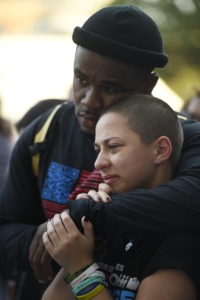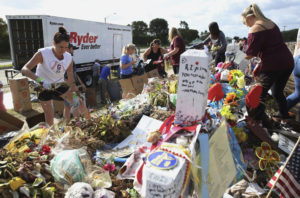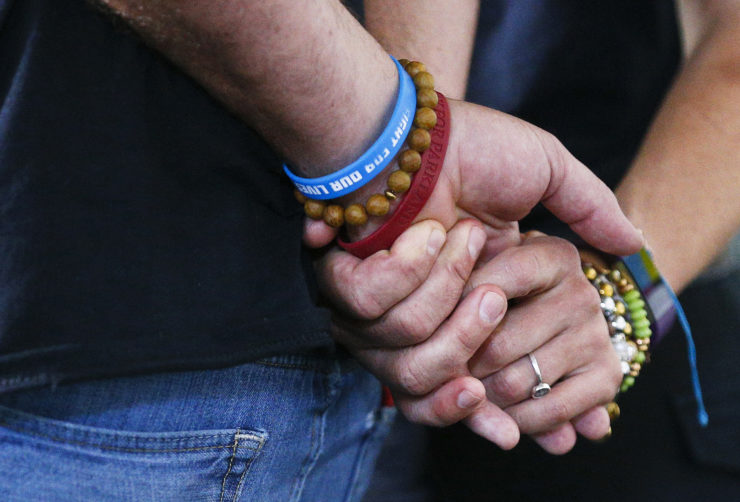This week marks a return to school for students around the country, including at Marjory Stoneman Douglas High in Parkland, Florida, where six months ago a gunman shot and killed 17 students and staff members. The massacre in Parkland was far from the first school shooting in America, nor the most recent. The sustained response to it, especially by the students involved -- a busload of whom spent the summer traveling the country speaking out about gun violence and registering citizens to vote -- hints at the possibility of a different future. Whether or not that happens, news headlines and daily lives will go on while the victims will be forever changed. And there will always be the need to find a villain.
In Parkland, one of those presumed villains was school resource officer Scot Peterson. In the chaotic days after the shooting, he was vilified in news reports, social media and by President Trump – not for what he did but for what he didn't. Peterson was the good guy with a gun who was huddled behind a barrier outside the school while the slaughter was carried out within. Three months after the shooting, Peterson remained huddled, but now inside his house, trying to shield himself from the headlines and the hate, and haunted by What Ifs.
I’m never trying to write stories from a place of judgment. I’m trying to write stories from a place of truthfulness and empathy and trying to help people understand what somebody’s experience is like.
While most reporters focused on victims, survivors and the circular gun-control debate, Eli Saslow of The Washington Post wondered about Peterson. In “It was my job and I didn't find him,” published June 4, 2018, Saslow sits us down in Peterson’s living room, has us watch videos of the shooting scene with him and invites us to listen as Peterson wrestles with his demons. The story is a study in narrative: tightly framed in time and place; steeped in character, dialog and detail; nuanced and nonjudgmental, yet unflinching.
But none of that would be possible without first gaining access and then a significant degree of trust from Peterson – a man who had little reason to trust a reporter. That’s what most interested me when I first read Saslow’s story: How’d he get that guy to talk to him?
The story opens inside Peterson's house. A motion detector goes off. Someone is on the porch. Peterson's girlfriend, Lydia, pulls back the sheet covering the window to peek out. We are expecting Saslow, or some other reporter, to be lurking there. Instead, it's neighbors Jim and Kelly, bringing a bag of cookies. Did Saslow get access through the neighbors? Was he there with them when they brought the cookies? If so, how did he construct the scene inside the duplex?
Intimate access is a signature of Saslow's narrative work. He won a Pulitzer in explanatory reporting in 2014, and has been a finalist for feature writing three times. Many of his stories are built on time spent with people at their most vulnerable moments. Curious about how he makes that happen – and particularly how he gained the trust of a demonized cop – I called him. (The conversation has been lightly edited for length and clarity.)
When did you decide to write about Peterson, the school cop from Parkland?
I was working on a story in Wyoming about guns, and the high-school girl I was writing about there at one point gave a speech to the school board in which she casually mentioned the cowardly officer in Florida. And that jarred me back: Oh yeah, that guy.
How did you get him to talk to you? What was your first move?
The first thing I did was I call his house. He didn’t pick up. Voicemail inbox was full. Then I tried his lawyer, who didn’t get back to me. I tried (Peterson) again. Didn’t get back to me again. So eventually I wrote a letter, explaining who I was and what I wanted to do and why I thought it was important and gave him some sense of the kind of stories I write and what it would be like. I didn’t have any expectations. The success rate on letters like that isn’t high.
When you write a letter like that, what do you say?
I say I write long in-depth stories and that I’d want to do this in a way that doesn’t shortchange what’s happening for you, and honors it with the depth and honesty and degree of detail it deserves. I’m not saying what the story is going be about or what I want it to say, because I don’t know yet. I say I’ve been thinking about it a lot, and a lot of other people have, too. That this is a story that could mean a lot to a lot of people, and could help them understand some things. It’s a very open-ended letter. It’s not my job to convince anyone to be written about against their will. In my experience those stories don’t work that well.
The other thing I say in those letters is, hey, I’d be happy to come down there, and we can grab dinner, off the record, and I can tell you what this is going to be like. You can get to know me a little bit and see if you feel comfortable. Or we can do that over the phone.
I’m lucky to have a job where my priority is getting the story right, taking as much time as that requires.
It's not my job to convince anyone to be written about against their will.
So you send this letter, and then what happened?
He e-mailed me a few days after getting the letter. Said, I got your letter, thanks, I’m thinking things through. Over the course of a week or so of e-mail back and forth, I explained this wasn’t the kind of thing where I’d just be showing up for an interview, but it would be me trying to spend a number of days inside his closed-off world. We talked on the phone, he thought about it some more, and eventually said, ok, let’s do it.
What happened when you got there?

The kind of reporting I like to do is where I can fade into the room and listen and watch things happen, but that first day, Scot (Peterson) was like a volcano that needed to explode. He’d spent three months thinking over this stuff again and again and not talking about it to anybody. So I knew I just needed to let him go, and do a full interview where we went through that day for like six hours. That was the best way to help him relax so I could begin to fade in on days two and three and four. After that first day, I would just come over to Scot and Lydia’s house, and they would pay some attention to me, but mostly other things were going on, and I was there petting the dog, asking questions occasionally, writing stuff down in my notebook when the neighbors came over, or when he was going out with an old friend, or about whatever he and Lydia were saying to each other as he was watching TV.
It is sometimes just an investment of time, so you hopefully can find some moments where it almost seems like you’re part of the furniture.
How long were you there?
Four days. I try to get there when people wake up and stay until they’re either so sick of me I can tell they need a break, or they crash out and go to bed. That was the case with Scot. I would go over to his house at 8 in the morning, and be with him until 9 at night. That was a hard skill to learn as a reporter – to get comfortable in situations that at first seem a little bit awkward. If you’re with people that long there are always moments where you feel like, oh, I should probably go.
I was there when the shooting (at Santa Fe High School) in Texas happened. Watching Scot see that story break, and sitting with him as he was watching the coverage on TV – it was so intimate and brutal. Your human instinct is to be like, I should give him a little space; I shouldn’t be here to see this. But those are the exact moments that, as a reporter, you’re there for. And Scot wouldn’t have agreed to have me do the story, and wouldn’t have agreed to have me sit there again and again, if he didn’t want me to be there.
In honoring the story, that’s the exact moment where I need to sit there and see that. That’s the only way people can see what’s going on in his life and what’s going on in his head and this constant circle that’s looping around in his brain.
You write about him watching a lot of videos. Did you set those moments up?

No. He’s constantly investigating that day whether I’m there or not. I don’t ever want to be writing a scene I created. There were things I did ask him to watch – for instance, the video where you can see him standing against the building. I asked can we watch this and you tell me everything that’s happening in your head every single second. But that’s not a scene in the story.
Are you starting to structure a story like this while you’re reporting?
It’s woven into the process. Often I’m thinking about it before I go, trying to figure out when I should time a trip, what things I should be there for, trying to arrive at moments in people’s lives where there’s movement so stories can begin and end in different places. Arriving when a lot is going on is advantageous for disappearing and being able to observe more, because if there are really important things going on in someone’s life they’re less likely to pay 100 percent attention to the reporter who’s there to chronicle it.
Arriving when a lot is going on is advantageous for disappearing and being able to observe more...
In this case I had some pretty clear ideas about structure early on. Certainly before I got on the plane going home I knew the story was going start when the neighbors came over.
How much time did you spend writing it?
I structured the story in a couple days, on the plane home and the day after that. Then probably took a low-key day. And then I wrote the story over the course of four or five days. I write a little more than a thousand words a day that I feel good about; it’s hard for me to go faster than that.
Were you wary of characterizing him as a victim or a misunderstood hero?
I think obsessively about being fair. Not just making sure the quotes are right but trying to finding out whether this is what it really is. In this case, that was particularly complicated. There are no easy answers. What happened was extraordinarily confusing. And pretty quickly in talking to him it was clear that pure cowardice didn’t explain everything. But it also wasn’t a story that was going to say he’d done everything exactly right or had been heroic in any way.
I’m trying to write stories from a place of truthfulness and empathy and trying to help people understand what somebody’s experience is like.
One thing I’m always trying to do in stories is embrace nuance and confusion and messiness. I’m never trying to write from a place of judgment. I’m trying to write stories from a place of truthfulness and empathy and trying to help people understand what somebody’s experience is like. The great thing about writing narrative stories that are built on scenes and dialogue is that when they’re done right, hopefully it feels pretty much like a direct interaction between the reader and the subject. Like they’ve been with Scot for four days. I wanted to allow people to experience in some extremely fractional way what the last months of his life have been like. And rather than me telling (readers) what they should think about him, they’ve seen it for themselves and can draw their own conclusions. The conclusions we draw ourselves rather than the things we’re told to think, those are the conclusions that stick with us.
Even in narrative journalism there are often moments of reflection by the writer, where he or she zooms out and articulates some larger meaning for the reader. This story has almost none of that. Did any early drafts have more?
That’s a great observation. I tried a paragraph like six times and my editor and I realized the story didn’t need it. It was coming off this paragraph about how all these months later all these investigations were still underway, and the next paragraph was something like, all these people were looking for someone to blame, because only when there was someone to blame did it begin to feel like any particular mass shooting was, in fact, preventable – something that could be solved – rather than a continuation of the national norm. It was me trying to inflict an idea that’s already there. It’s part of the essence of the story.



